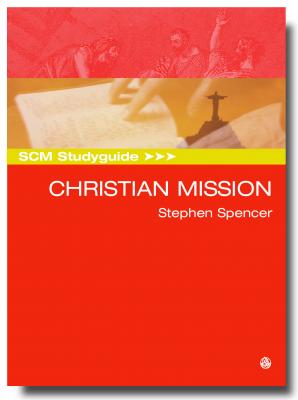ТОП просматриваемых книг сайта:
SCM Studyguide: Christian Mission. Stephen Spencer
Читать онлайн.Название SCM Studyguide: Christian Mission
Год выпуска 0
isbn 9780334048046
Автор произведения Stephen Spencer
Жанр Журналы
Издательство Ingram
SCM STUDYGUIDE TO CHRISTIAN MISSION
Historic Types and Contemporary Expressions
Stephen Spencer
All rights reserved. No part of this publication may be reproduced, stored in a retrieval system, or transmitted, in any form or by any means, electronic, mechanical, photocopying or otherwise, without the prior permission of the publisher, SCM Press.
© Stephen Spencer 2007
The Author has asserted his right under the Copyright, Designs and Patents Act, 1988, to be identified as the Author of this Work
Scripture quotations are from the New Revised Standard Version of the Bible, copyright 1989 by the Division of Christian Education of the National Council of the Churches of Christ in the USA. Used by permission. All rights reserved.
British Library Cataloguing in Publication data
A catalogue record for this book is available from the British Library
978 0 334 04108 5
First published in 2007 by SCM Press
9–17 St Alban’s Place,
London N1 0NX
www.scm-canterburypress.co.uk
SCM Press is a division of SCM-Canterbury Press Ltd
Typeset by Regent Typesetting, London
Printed and bound in Great Britain by Biddles Ltd, King’s Lynn, Norfolk
Contents
2. Origins of a Word: Mission as Missio Dei
3. Digging Deeper: Mission as Participation in the Trinity
4. In Human Terms: The Prophetic Mission of Christ
5. Filling the Ark: Apostolic Mission
Background: Jewish Christianity (c.40–100 AD)
Jewish-Christian apostolic mission
Case study: Paul’s calling
Some more recent expressions of the type: Protestant and Catholic
Debate
6. Radiating Eternal Truth: Hellenistic Orthodox Mission
Background: the rise of Platonic philosophy within Christianity
Christian mission within the Hellenistic paradigm
Case study: Antony of Egypt and the founding of monasticism
Some recent expressions of the type: Michael Ramsey’s theology and Taizé
Debate
7. Establishing Christendom: Medieval Catholic Mission
Background: the impact of Constantine and Augustine of Hippo
Mission within the medieval Catholic paradigm
Case study: Pope Gregory VII and Roman supremacy
Some other expressions of the type: the establishment of the Church of England
Debate
8. The Conversion of Souls: Protestant Reformation Mission
Background: Augustine’s awkward legacy and Luther’s doctrine of justification by faith
Mission within the Protestant Reformation paradigm
Case study: the awakening of John Wesley
Some recent expressions of the type: Pentecostalism
Debate
9. Building the Kingdom on Earth: Enlightenment Modern Mission
Background: the Enlightenment and Hegel
Mission within the Enlightenment modern paradigm
Case study: William Temple and the founding of the welfare state
Some recent expressions of the type: liberation theology and Faith in the City
Debate
10. Finding Hope in Local Communities: Mission within Postmodernity
Background: twentieth-century crisis and Karl Barth’s theology
Mission within postmodernity: Bonhoeffer’s legacy
Case study: Vincent Donovan and the Masai
Other recent expressions: the emerging church movement
Debate
Conclusion: Which Type of Mission?
Epilogue: The Coming of the Rains
Preface
This is not a history of missionary work or a guide to the practicalities of being a missionary but an introduction to the predominant ways the Christian community has understood and practised mission. It does this by identifying a number of ‘types’ of mission which have emerged through Christian history and which continue to be influential in different parts of the Christian world today. In adopting this approach it follows in the tradition of Max Weber (1864–1920) who developed the notion of ideal types, which he described as ‘analytical constructs that enable us to simplify a set of social relationships, to detail what is relevant and exclude misleading complexities’ (in Graham, Walton and Ward, Theological Reflection: Methods, SCM Press 2005, p. 11). A type, then, is a concept which helps to identify and understand the essential features of a more complicated phenomenon. Ernst Troeltsch used this approach to describe the life of the churches, identifying two basic types – the church type and the sect type. A number of other writers have followed his example, adapting and extending it, most recently Elaine Graham, Heather Walton and Frances Ward in relation to theological reflection (ibid., especially pp. 11–12). This book uses this approach to introduce Christian mission. It draws on the work of Hans Küng and David J. Bosch, especially on the six historical paradigms of Christian life and mission that they describe, and out of these it develops and presents six ‘types of mission’. It does this through a number of historical portraits which are indicative and exemplary of the development of each type.
This Studyguide, then, seeks to provide an overview of different approaches to mission, an overview in which contemporary views and practices can be located and understood. It does this especially for those working at undergraduate Levels 1–2, though the book is also aimed at a wider audience of any in the Church or society who wish to gain an understanding of the varied and

